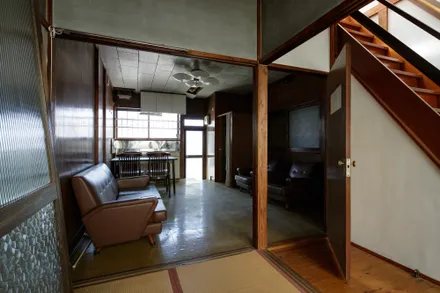Megurohoncho House
ARCHITECTS
Roovice
PHOTOS
Akira Nakamura
STATUS
Built
AREA
0 Sqft - 1000 Sqft
YEAR
2021
LOCATION
Meguro City, Japan
TYPE
Residential › Private House
Built in 1953 during the Showa Era, the Japanese period that goes from 1926 until 1989, the house, together with the whole block where it’s located, presented many features typical of that time.
The Showa Era went from the early traditional architecture (strongly influenced by the previous more conservative approach) to modern western-style buildings, brought to Japan after the modernisation of the country during the 1950s.
It is also fundamental to mention the Japanese custom of demolishing and redesigning buildings after 30 years, to embrace technological and structural improvements and new market value.
Given all these factors, it’s easy to understand why this renovation was so inspiring for the architects, giving them the chance to bring back some of that atmosphere into nowadays life.
Until the late XX century, the use of public baths was really popular in Japan, and that was a major influence while designing residences in the country.
In fact, the majority of dwellings from that period don’t even have the room nor the space for a bathtub, making them obsolete for contemporary standards.
The design process of Megurohoncho House started indeed from the requests of the client to solve the above-mentioned problems:
to modernise the structure with the newest seismic retrofitting methods, incorporate a private bathroom and increase the amount of natural light in the first floor.
First thing was to focus on reinforcing the existing wooden structure by starting anew the whole layout of pillars and walls in the lower level: so the design team removed the walls at the entrance, and placed a new light one to divide the kitchen facilities from the bathroom behind.
In this way the whole floor is more open, bright and flexible. As a storage for kitchen tools there is a traditional Japanese chest, a leftover of the original furniture.
For the material, a custom texture for the OSB panels was chosen: after applying a first and rough layer of grey paint, on top of that a layer of white putty, and finally one more cover of clear paint.
The result is surprisingly cheaper and quicker than a wall made of plaster board and painted with a white coat would have been.
For this reason, the second floor was designed mainly with the aim to enlighten as much as possible the space below: that explains the use of a FRP (Fibre-reinforced plastic) grate for the hallway.
Prior to renovation, the house was dealing with severe lack of natural light, especially in the entrance hall.
On top of the corridor a zenith window helps to capture and let light pass through the floors that, together with the new entrance layout, creates a lightful yet calm atmosphere.
Beside the new hallway floor, the renovation in the second level brought minor changes. The toilet at the end of the corridor has been replaced with a storage room.
The two bedrooms' tatami floor got replaced by wood panels and division between the two rooms is now made of light movable panels, thus creating one continuous space if needed.

On top of the movable panels, the original ranma, an element of the traditional Japanese architecture that allows ventilation and lightning between two spaces divided by a wall, that works as a threshold when the panels are opened, has been left in its place.
This house is part of the Kariage service (カリアゲ) program, meant to regenerate and sublease vacant properties built 30 or more years ago, at no cost for the owner.






































